#pay says stuff
Text
i got rickrolled today but it didn't work because i have adblocker installed, so youtube just told me i violated the terms of service. yesterday i was trying to edit a picture as a joke for my girlfriend, and google made me check a box to prove i'm human because i wasn't "searching normally".
it isn't just that capitalism is killing fun and whimsy, it is that any element of entertainment or joy is being fed upon by this mosquito body, one that will suck you dry at any vulnerability.
do you want to meet new friends in your city? download this app, visit our website, sign up for our email list. pay for this class on making a terrarium, on candlemaking, on cooking. it will be 90 dollars a session. you can go to group fitness, but only under our specific gym membership. solve the puzzle, sign up for our puzzle-of-the-month-club. what is a club if not just a paid opportunity - you are all paying for the same thing, which makes you a community.
but you're like me, i know it - you're careful, you try the library meetings and the stuff at the local school and all of that. the problem is that you kind of want really specific opportunities that used to exist. you are so grateful for libraries and the publicly-funded things: they are, however, an exception - and everything they have, they've fought tooth-and-nail to protect. you read a headline about how in many other states, libraries have virtually nothing left.
do you want to meet up with your friends afterwards? gift your friends the discord app. you can choose to go to a cafe (buy a coffee, at least), a bar (money, alcohol) or you can all stay in and catch a movie (streaming) or you can all stay in bed (rent. don't get me started) and scream (noise complaint. ticket at least).
you want to read a new book, but the book has to have 124 buzzwords from tiktok readers that are, like, weirdly horny. you can purchase this audiobook on audible! your podcast isn't on spotify, it's on its own server, pay for a different site. fuck, at least you're supporting artists you like. the art museum just raised their ticket price. once, they had a temporary exhibit that acknowledged that ~85% of their permanent art galleries were from cis white men, and that they had thousands of works by women (even famous women, like frida! georgia o'keefe!) just rotting in their basement. that exhibit lasted for 3 months and then they put everything away again.
walmart proudly supports this strip of land by the street! here are some flowers with wilting leaves. its employees have to pay out-of-pocket for their uniforms. my friend once got fined by the city because she organized a community pick-up of the riverfront, which was technically private property.
no, you cannot afford to take that dance class, neither can i. by the way - i'm a teacher. i'm absolutely not saying "educators shouldn't be paid fairly." i'm saying that when i taught classes, renting a studio went from 20 bucks an hour to 180 in the span of 6 months. no significant changes to the studio were made, except they now list the place as updated and friendly. the heat still doesn't work in the building. i have literally never seen the landlord who ignores my emails. recently they've been renting it out at night as an "unusual nightclub; a once-in-a-lifetime close-knit party." they spent some of those 180 dollars on LEDs and called it renovating. the high heels they invite in have been ruining the marley.
do you want to experience the old internet? do you want to play flash games or get back the temporary joy of club penguin? you can, you just need to pay for it. i have a weird, neurodivergent obsession with occasionally checking in to watch the downfall and NFT-ification of neopets. if i'm honest with you all - i never got into webkins, my family didn't have the money to buy me a pointless elephant. people forget that "being poor" can mean literally "if i buy you that toy, i can't afford rent."
you and i don't have time to make good food, and we don't have the budget for it. we are not gonna be able to host dinner parties, we're not made of money, kid. do you want some kind of 3rd space? a space that isn't home or work or school? you could try being online, but - what places actually exist for you? tiktok counts as social media because you see other people on it, not because they actually talk to you.
there was a local winter tradition of sledding down the hill at my school. kids would use pizza boxes and jackets and whatever worked, howling and laughing. back in september, they made a big announcement that this time, rules were changing, and everyone must pay 10 dollars to participate. when im not scared shitless, i kind of appreciate the environmental irony - it hasn't gone below 40. so much for snow & joyriding.
i saw a bulletin for a local dogwalking group and, nervous about making a good first impression, showed up early. the first guy there grimaced at me. "sorry," he said. "there's a 30-dollar buy-in fee." i thought he was joking. wait. for what? the group doesn't offer anything except friendship and people with whom to walk around the city.
he didn't know the answer. just shrugged at me. "you know," he said. "these days, everything costs money."
#spilled ink#warm up#“why did u tag it warm up” bc i wrote it off the cuff while drinkin coffee lol#btw the 30 dollar buy in for the dog walking is bc they pay the organizer a small pittance so she can#run fb ads and stuff and like she does put in a lot of work i don't mind paying her#but that's exactly what im fucking talking about like.#ppl can't afford to volunteer their time anymore and we all understand it!!! everything costs money for everyone!#like we didn't have to use to say ''do you mind paying me back for the stuff we ate''#we used to be able to afford to feed our friends once in a while!!!
47K notes
·
View notes
Text
reading a new interview and seeing larian's lead writer refer to gale as "the guy who annoys everyone" and "constantly eats your most treasured possessions" really explain a lot of things that are in the game tbh
#they also consider the ending where he blows himself up as the 'right' ending#truly a Great Message to send#'you deserve to die after making a mistake and taking someone up on their offer to help you it's just the price you have to pay'#also saying that halsin's quest ended in act ii and now he's just there plus#admitting that you dumbed stuff down and made characters 'nicer' for whiny redditors is... Interesting too#truly Choices were made#ch: gale dekarios#vg: baldur's gate 3#series: baldur's gate#text: personal#bg3 critical#larian critical
375 notes
·
View notes
Text

Im in history class rn lmao
#Were talking about the aftermath of the wall opening up in germany after ww2 and im over here like#“Hehe hoho genloss :]”#Dw i am paying attention tho#i art#ranboo#ranboo fanart#genloss#generation loss#Genloss fanart#generation loss fanart#generation loss spoilers#ranboo art#this is from the fight scene in the first ep hui efhi#You can hear em say stuff like that#And the mask blinks#GOD genloss is so cool#Anyway german history lessgooo
899 notes
·
View notes
Text
also be so serious right now, if the announcement was an onlyfans y'all would be clamouring to give them your dollars.
#things jess says#y'all just hate that they wanna make you pay for stuff you used to get for free like babies who haven't learned that the world costs money#watcher#watcher entertainment
187 notes
·
View notes
Text
Not to be melodramatic but "you've got to get better, you're all that I've got"/"I've got to get better, I'm all that I've got" might be one of the most beautifully raw and heartwrenching lyrics I've ever heard sung before. Like. Shoot, man. I really am all that I've got.
#no joke this is motivating me to get some self care#And some past self forgiveness#no matter what I want or what I wish would have happen I'm all that I've got. And I have to get better. For myself.#Also can I just say Caiden vibes#Like her Bad Day episode/chapter#(and Dmitri vibes but for a spoiler-y reason)#But yeah this is so THC-core you have not even a clue#(I'm rambling about my original stuff by the way pay no mind)#I'm just super emotional about TMM#Imagining a TMM themed tattoo and it'll either be about Inertia or Maybe Man or 2085#AJR#The Maybe Man#TMM#aaaaaa!#trying to think of other songs that made me this emotional but head is empty only full of 2085
230 notes
·
View notes
Text
grrm having stannis baratheon be a harsh and often unlikable character who is nonetheless first introduced through the eyes of someone who loves him and basically raised him as a son was kind of genius tbh. the reader hears so much about stannis throughout agot but never actually sees him on page, and that one chapter really does cut straight to the heart of the character. every time i see someone hating on him i’m like dude didn’t you read the prologue of a clash of kings? that’s maester cressen’s sad sullen boy you’re talking about!
#reading many posts about stannis and renly in the last couple of days has reminded me that i am rather attached to the baratheons#prologue of acok is honestly brilliant it's such a good introduction to the whole dragonstone crew and stannis as a character#asoiaf#valyrianscrolls#pie says stuff#stannis baratheon#maester cressen#it's a good thing i wasn't really paying attention to game of thrones during the stannis character assassination season would've been SO MAD
1K notes
·
View notes
Text
I've been reading Exodus lately and I've just gotten to the portions where God gives the first commands to the people via Moses (twice), and then goes on to give detailed instructions about the tabernacle and how it should be built, and I'm just... we think art is unimportant?? we think things only mean as much as their functionality?? we so easily fall into the trap of believing that beauty means nothing, that it's cheap and only worth whatever mindless distraction it brings, that it's barely more than a cheap sensual thrill, that buildings should just be practical and plain and cheap, that everything should be functional but ultimately disposable, that paintings and dresses and mugs and curtains and carpets are just pretty but have no real value, that beauty is fleeting and vain and therefore shouldn't be thought about too much, if even looked for at all... we fall into these traps so easily, and we forget that there are chapters upon chapters of painstakingly detailed plans to build one portable worship tent, and those plans have been handed down through thousands of years of human history, because beauty and art and skill in craft is important
#I have to go get ready for work now but I will come back to this#and don't even get me started on the parts about God calling specific craftsmen *by name*#he called them!! by name!!! he said 'this man is good at his job. he creates beautiful work. he will build my temple and make it beautiful'#and even more--God inspired him!!!! it was a calling of GOD for him to create beautiful carvings and tapestries and candlesticks!!!#look even if you're not jewish or christian or religious at all you have GOT to see what it means that all these incredibly detailed plans#for building this tent-temple are extremely important#because even if you don't believe in God and don't think that this is all significant bc he personally gave the instructions#and then helped preserve this record of them so we could still read them today#you do have to see how important they were to the people of that time who first wrote them down#and the extreme care that was taken to record all of those detail#AND the fact that it's been preserved for so long and we can still read all the care that was put into creating this incredible piece#of artwork and worship they made#gurt says stuff#I just. gahhfhhfj. I'm feeling emotional about chapters of the Bible that I can't even fully force myself to pay attention to#bc there's so MUCH and I'm bad at visualizing this stuff and I tend to zone out while listening to it#but the fact that it IS that much!!! that there SO MUCH DETAIL and it goes on for SO LONG that I even struggle to pay attention!!!#that this was THAT IMPORTANT to the people who wrote it and to God!!! as an artist and someone who has always cared about art#this means so much to me ok#christianity#bible verse#bible thoughts#exodus#art#theology
616 notes
·
View notes
Text
Me: Alright, time to get up and go wash dishes, hopefully I'll be done soon so that I can—
My brain: Hey. Hey hey hey hey hey psssst hey
Me: ......what?
My brain: Why's Alphys built like a Sandshrew
Me:
My brain: Sandshrew Alphys
Me: What???
#not skeleton stuff#not necessarily at least#rambles#say hello to my adhd guys#its the tenant in my head who refuses to pay rent#undertale#alphys#undertale alphys#alphys undertale
84 notes
·
View notes
Text
hi! ok so i'm going to talk about one of my top-five favourite things, which is: dyeing stuff! this is going to be specifically about dyeing protein fibres (animal fibres—wool, alpaca, silk, etc) in a pretty low-key way in your kitchen.
to be clear up front: this is not the most scientific, most perfectly reproducible, or most Objectively Correct way to dye things. i get a lot of fibre that i like this way, though, and i think that other people can, too.
fibre i've dyed that i think is neat:
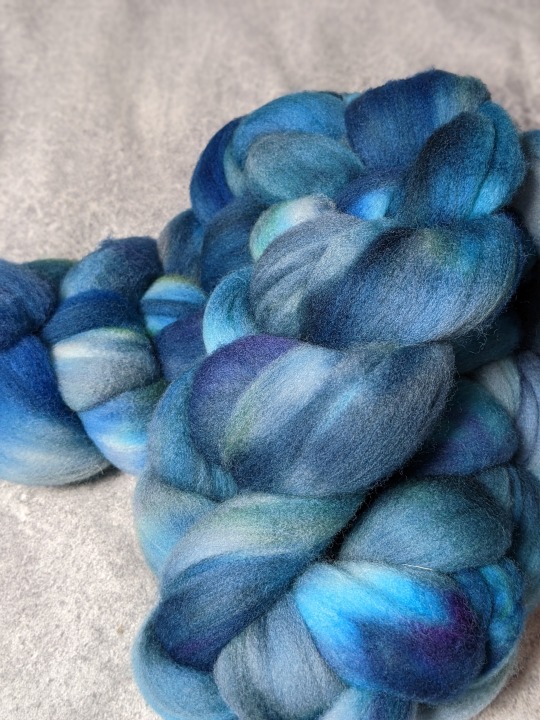
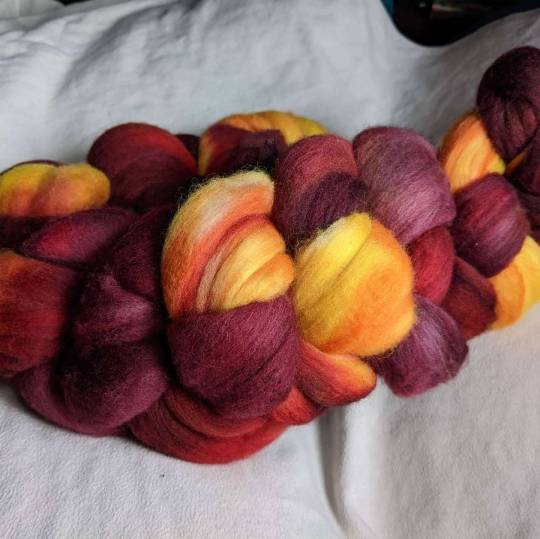

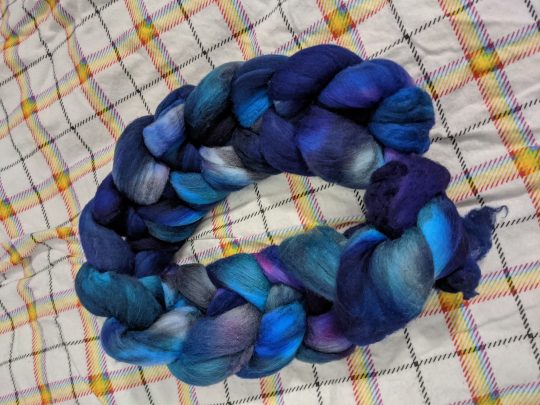
you can also dye yarn like this:

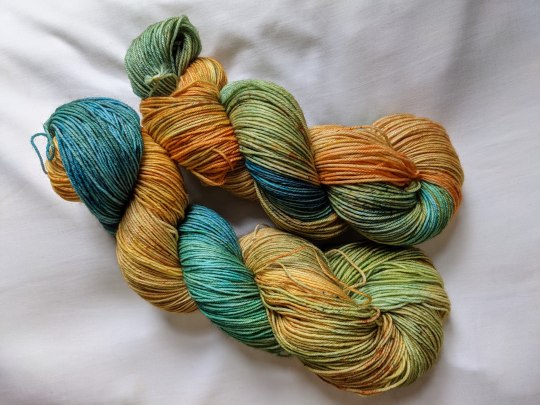
yes, i like blue a lot. i also really like variegation and heathering, which is why most of the fibre here has patches of white—it's an intentional choice that i've made. you can make different choices.
here is what you need to dye things:
fibre, vinegar, dye, a pot, heat, and some water.
that was so you don't get overwhelmed by the impending wall of text. here is what you need to dye things (it's the same stuff!), but with way more detail:
fibre or yarn. this is the big one, obviously. i tend to dye in 100-200 gram batches, because that's approximately what fits on my stovetop easily. if you're very nervous about felting or harming your fibre, you can use stuff that's been treated to be superwash, start with yarn (which is harder to felt than fibre is), or use a felt-resistant breed like dorset or suffolk. honestly, though, i learned with merino because that's what i had, and it was fine. again, though, this guide is only for protein fibres. it will not work for things like cotton. the only exception to this is nylon, which will take on some colour, but less than a protein fibre will.
a mordant. this is a fancy way of saying a thing that makes dye stick, and for what we're doing here, it's citric acid or vinegar. your grocery store definitely has at least one of them, though if you can choose, i prefer citric acid, because i love wet wool smell but i do not always love wet wool vinegar smell.
dye. i use acid dyes, and am personally deeply loyal to dharma acid dyes, but ashford and jacquard acid dyes work the same way. if you don't want to buy dye or don't have access to it, food colouring will often work, as well, though i haven't tried this with natural food colourings and have no idea how well they'll work.
a dedicated dye pot. ok, if you're doing food dyes, you don't need this. if you're not, it's definitely best practice, though i don't know how dangerous it is not to. any large metal pot will do, but my favourite option is hotel pans, which are those huge metal pan/tray things that hold food at buffets and the like. i have a full-size one that's 15cm deep, and a half-size one that's 4cm deep. they're great because they let you lay out the fibre you're working with so you can see most of it in a single layer.
dedicated dye utensils. as before, i don't know how much of a huge deal this is. i'll be honest and admit that for several years i had a single pair of tongs that got used for all tong-requiring events, including dyeing, and i'm still alive. i suggest that you have at least a big spoon, and a big spoon and tongs are even better.
something to mix the dye in. yeah, i use empty plastic sports drink or soda bottles for this. you can be fancy and get mason jars or little squirt bottles or whatever, and if you get super into dyeing you'll want to mix up dye stocks, but that's way outside the scope of what we're doing here. i like the powerade bottles that have a little squirty mouthpiece, because it's fun to squirt dye onto things.
personal protective equipment. i think this is the part of things that freaks people out. ideally, you wear plastic gloves and a mask (yeah, like your covid masks) when you're working with dye. realistically, i almost never remember to put on gloves and just accept that my hands are going to be blue sometimes. you should wear a mask, because dye is an irritant, but the world is an imperfect place and i have wicked bad adhd and sometimes i forget. this isn't advice. i'm just being honest. you should use some kind of safety stuff. you probably won't die if you don't.
you might also want some little random bits: an old toothbrush or paintbrush, a pipe cleaner, some toothpicks, etc. this is mostly if you like speckles, or if you want very small patches of colour.
so first: there are a million ways to dye things, and i'm not convinced that any of them are objectively correct. i do what i do and it works for me. some of the things i do are the opposite of what most guides suggest, but i do them because i like the effects they create.
ok, that's all the background stuff you need. let's dye some stuff!
the number one most important thing to remember when you're dyeing is this:
you can always add more colour. you cannot take it away.
that's in fancy writing and bold because every once in a while i forget this, and every single time i end up regretting it.
here is how to dye things:
put water, citric acid (or vinegar), and fibre into a pot. add dye and heat. let cool completely. rinse the fibre in cool water, then hang to dry.
like, sure, we're going to go into way more detail, but push come to shove, if you do that, you're going to end up with dyed fibre. there are a lot of tutorials telling you that you must soak your fibre first, or you must add your citric acid this way, or hold the water at exactly this temperature, and i'm here to tell you that while any of these things can give you different results, those results aren't necessarily better.
the only way that you can totally screw this up is by accidentally felting your fibre, so before i get into the way more detail part of things, i'm going to talk about that.
how not to felt your fibre
i feel like if you've read this far, you know how things felt: wool, heat, and agitation. you may also notice that at least two of these things are required for dyeing. this can be stressful! but you don't have to be afraid of it. there's only been one time that i felted something to the point that it was unusable, and that happened because i literally fell asleep for several hours while the pot was on the stove. you can avoid doing this by simply setting an alarm—this is a good idea anyhow, because you'll want to check on your dye pot!
when you're dyeing, use the lowest heat that you can while still keeping the water at a simmer. if your stove, like mine, has one burner that's wildly unpredictable and sort of out of control, you may want to look for some sort of flame diffuser, also called a flame tamer or a simmer ring. i bought one on amazon for about fourteen dollars, and it's literally just a thick metal circle. it works fine.
you can also keep the heat low by using a pot with a thick bottom, though in my experience those are expensive, and if i had one i would be using it for soup, not wool.
avoid shocking your wool—never put room temperature wool into hot water, and never put hot wool into cold water. leave your wool in the dye bath until it's cooled completely, which for me usually means overnight.
finally, obviously you have to move the fibre around some. you'll need to peek under it in the pan, and when you're done, you have to rinse it and squish out the water. try to minimise handling, though. don't run water directly onto the fibre, don't get a wooden spoon and stir your dye pot around, don't wring the fibre dry when it's done.
you're probably never going to be perfect. i often find that i lose a gram or two of wool where fibres have grabbed onto each other, or where parts of the ends clumped up. it's not really felted, just sort of compacted, but it's not great to work with, and i'd rather lose a gram of fibre than fuss with the clumpy bits.
back to how to dye things
let's take it step by step, assuming a hundred grams of fibre.
put your pan on the stove and fill it halfway with water. add either a teaspoon of citric acid or a tablespoon of vinegar. this is going to help the dye strike, or stick to the fibre. the teaspoon/tablespoon is a guideline, but one that it's fine to exceed. adding more will help the dye strike faster, which can be useful if you're trying to create blocks of colour on your fibre. i usually err on the side of a little more than the guidelines, and just eyeball this—if you feel like the dye isn't taking well, you can add more later.
add your fibre to the pan. this is the first place you have to think about what you want the finished fibre to look like! you can put it into the pan any way you want, but i suggest trying to keep it in a relatively even layer, regardless of what that layer looks like. here are some ways to get specific effects:
if you want a gradient from one end of the fibre to the other, use a rectangular pan and lay your fibre out so that the line of it is parallel to the short sides of the pan
if you want a short, repeating gradient, use a rectangular pan and lay your fibre out so that the line of it is parallel to the long sides of the pan
if you want something that starts with very close repeats that get further apart as you go down the fibre, make an approximate spiral
if you don't want A Pattern (i usually don't) just lay things out in a single layer, more or less
here comes the next exciting part! decide if you want to let your fibre soak or not. again, doing or not doing this gives you some different effects!
soaking your fibre will mean that dye takes more evenly. if you want consistent colours, you'll want to soak.
not soaking your fibre means that the dye takes less evenly. the fibre on top will have less acid available to it, spends less time in the dye bath, and also has to actually get wet before it will start to dye. i actually love doing this, and think it affords a lot of cool opportunities to play with and layer colours.
if you're soaking, leave the fibre there until it's submerged. if not, don't.
now you're going to add dye! decision time, again.
you can add dye when the water is cold, which will give you more even dye coverage, and in my experience gives the colours more time to mix together
you can add dye when when the water is hot, which will give you less even coverage, and tends to encourage the colours to stay more delineated
probably surprising no one, i tend to heat the water first unless i'm starting with a base colour or i'm doing a two-colour gradient.
time to mix up some dye
as i mentioned earlier, i'm assuming that you're using powered acid dyes for this. if you're not, this mixing up part is technically optional—but doing it gives you way more control about how and where you place your colours, so i'm going to assume that you'll do it.
i usually mix dye in some sort of empty drink bottle. regardless of what you're using, before you add dye to anything, put some water in the bottle, wipe off the lip, put the lid on tightly, and shake the bottle vigorously. if there is any leakage at all, do not use that bottle. find a better bottle. if your bottle cap doesn't seal well or if you have an empty condiment bottle that's just a little wonky or whatever, you will get dye all over the kitchen, and your landlord will be really really mad about it, and you will regret your life choices. (if you own your kitchen, you can do whatever you want, but this isn't about you and you know it.)
so you have a bottle that seals tightly! great job. dump out the water and carefully put some dye powder into the bottle. remember earlier how i said you should be wearing a mask? this is the part where you should be wearing a mask.
i know that people are reading this and going, ok, but how much dye do i put in?
my answer is put in the amount that feels right in your heart, and don't forget the number one rule of dyeing things, which is that you can always add more colour, but you cannot take it away.
this isn't a very scientific answer. most dyes have a guideline about how much to use, expressed as a percentage of the dry weight of the fibre, which is what you use to get the whole quantity of fibre dyed evenly. for dharma dyes, it's like 1.5-2%, i think ashford is 1%, and jacquard is more like 2-4%, depending on the colour.
here is the problems with doing that in your kitchen: first, using that much dye will get you an evenly dyed piece of fibre, which—for me, at least—is basically the opposite of what i want. second, and more importantly, unless you have one of those teeny tiny scales used by jewelers and drug dealers, your kitchen scale will not weigh out such tiny quantities with any accuracy. third, if you do it like this, you really have to plan what you're doing ahead of time, because there's a point after which no more dye will bind! the fibre will be like enough thank u that's it i'm good and that'll be it, so you lose some of your ability to decide that actually, you want more green.
you can probably guess, at this point, that i don't weigh the dye. once you've done a couple batches of fibre with a given brand of dye, you'll start to get the vibes for how much you should use. if you really want a guideline, for a hundred grams of fibre, start with a quarter teaspoon of a given colour. you can add more—either more of this colour or a different one—later, as desired.
put your dye in the empty bottle, and then fill the bottle partway with hot water. the amount of water doesn't really matter here, nor does the specific temperature of the water. i usually fill about 3/4 of the way, because that way there's plenty of room for this next step, which is: wipe the lip of the bottle, recap it tightly, and then shake it up real good. the dye powder is going to dissolve into the water, and you now have a bottle of dye!
if you're going for a gradient, you might want to mix up your second colour so you can add them at (basically) the same time for more even mixing. if you're not, or if you only have one mixing bottle, you can do them one at a time.
oh my god we're finally putting dye on the fibre
are you ready? it's time!!
you have basically infinite options for how to do this, and many of them will give you different effects. here are some ideas:
pour the dye all at one side of the pan. and if you don't add anything else, your fibre will fade from the colour of the dye to the natural colour of the fibre
pour two colours, one at either side of the pan. depending on how much dye you use (and remember, you can always add more), this will give you either chunks of colour surrounded by white, or a two-colour gradient
add all the dye to unheated water and mix it gently, then let the fibre soak for a few minutes longer before turning on the heat. this will give you a fairly even colour
pour randomly all over, and you'll either end up with a tonal yarn or a heathered one, depending on how much dye you're using
add the dye to the water under the dry fibre, which will sink in and take up more dye on the bottom of the fibre than the top
if your heat wasn't on before, it should be now, and you're going to let the dye hang out in the hot but not boiling water for a while. how long? well, one of the cool things about dyeing with these dyes is that they exhaust, which means that when the dye has been sucked up by the fibre, the surrounding water will be clear. how long this takes will depend on the specific dye, how much of it you used, how much mordant you used, etc. i try to check every fifteen minutes.
reminder: if you started with room temperature water, the dye's not going to start taking until the water heats up, so don't check it after fifteen minutes and freak out that nothing has happened. it is fully normal for it to take up to an hour for the dye to exhaust. don't turn up the temperature, just give it time.
yay it worked!
at this point, you have a pot of hot water with some beautifully coloured fibre in it! but maybe it's not beautiful enough. maybe you want...more colours.
that's cool as hell and you should go for it. we mentioned two-colour gradients up there, but what if you want something else?
the answer, probably obviously, is adding more dye.
first, a caveat: while you can successfully make multicoloured gradients like this, it's more difficult than you think, and if it gets messed up—all the colours bleed into each other, say—it turns into a muddy mess. my suggestion is to stick to two (or three at most!) colour gradients until you have a much better feel for what you're doing.
let's talk about ways you can add more colour. you have two options: big colour and little colour.
big colour is going to add a lot of colour—you're going to mix up the dye and pour it just like you did before, but paying more attention to places that don't have dye yet. sometimes it's the middle of a gradient, or the white splotches from random pouring, or the half of the fibre that wasn't submerged when you started. or maybe you dyed the whole thing yellow, and now you want to add a blue gradient over top. whatever!
if you don't want to freehand pour, consider buying a couple large syringes, or a bottle with a squeezy top. these are also fun because you can easily get more colour between the laid-out fibre, or even under it.
in the pictures at the start of this post, the red-and-gold top and both yarns were dyed by adding big colour.
little colour isn't going to add big patches, but is going to add speckling, tonal depth, or smaller patches of colour. all of the blue-base fibres and the yellow-and-blue yarn were dyed like this.
if you're still reading this closely, you might have caught that i just said both yarns were dyed with big colour, and that the yellow-and-blue yarn was also dyed with little colour. these are both true! the base colours of the yarn were done to make big colour, but if you look at the full-size image, there are also a bunch of speckles. you can do whatever you want! no one can stop you!
here are some ways to add little colour:
mix up some dye, but use less water. add drops of the dye, either directly onto the fibre (more dramatic!) or in the water (tonal!)
use a toothpick to grab a little bit of dye powder and drop it into the dye bath (similar to the previous one, but a little less predictable)
put on a damn facemask. take a clean toothbrush, paintbrush, or pipecleaner, and just barely touch it to the dye powder. gently flick or tap the brush to add speckles of that colour
find a salt shaker that you're never going to use for anything but this. put citric acid, salt (to make it distribute better), and dye powder into it, and shake it up (with the holes covered, please cover the holes) to make sure they're evenly distributed. gently shake this over the fibre to add speckles, but more of them, and clustered together
put a little dye in a spray bottle and gently mist the exposed fibre, kinda glazing it with colour
another thing is that if you like a natural coloured yarn with dyed speckles, you can do any of these techniques without doing big colour first. the only thing to note when doing this is that you'll want to be very sure to spread out the fibre well, and maybe to consider dyeing one side, then very very carefully flipping it over and getting the other side.
ok, now what?
let's say that you've added all the colours that you want, and you've let your bath simmer long enough that the water is clear, or nearly clear. (if it's not, check troubleshooting, below.)
put the lid on your pan and walk away. if you don't have a lid, just walk away, but it's less dramatic.
the super frustrating part here is that the safest thing to do is wait until the water and fibre is fully cooled before you do anything else.
have i ignored this? yes
has it ever gone horribly wrong? not horribly wrong, but it's definitely caused me to lose an inch or two of roving on occasion
is it way more stressful if you don't wait? absolutely yes
honestly maybe just go to bed and deal with your fibre in the morning
so now let's say that it's morning and you slept long enough that your water and fibre are both room temperature, which often actually feels quite cool on your hands.
you have to drain your fibre. there are two ways to do this:
lift the fibre out of the water. this has the upside of not risking dumping your beautiful fibre into your sink, and not needing to maneuver a full pot of water, both of which are admirable. the downside is that wet fibre is fragile, and you'll want to be careful to support it.
dump the water out of the pan. this has the upside of minimising how much handling you're doing of the fibre, as well as (in my opinion) making rinsing easier. the downside is attempting to keep the fibre into the pot while you dump the water into the sink, and also needing to carry around a full pot of water.
secret third option: dump the fibre (and the water) into a strainer. upside: very easy, and you can keep the fibre in the strainer while you rinse, minimising both how much it needs to be handled and the weight on the fibre. downside: i never remember that this is an option until i'm already elbows-deep in acidulated water, discovering every tiny cuticle tear.
you're going to fill your dyepot with water again so that you can rinse the fibre. you want to minimise thermal shock, so keep the water temperature as close to the temperature of the fibre as you can, and don't run the water directly onto the fibre. i like to pull all the fibre to one side of the pan, and fill the pan on the other side.
side note: if you, smart person, remembered that you can use a colander, simply fill a pot with water, put the colander in the pot, and gently agitate the colander.
if you, person who is deeply relatable, did not remember you can use a colander and now have a pot with clean water and fibre, gently move your fibre in the water to encourage any excess dye and also citric acid to get out of there.
drain your fibre again, and this time, you're going to squeeze it dry. you're still trying to minimise agitation, so this isn't a 'wring it out' situation, it's a 'gently squish it between your hands and/or a hand and the side of the pot' situation.
hang your fibre to dry. remember what i was saying earlier about it being fragile? let me suggest, here, that you do not simply drape the entire length over a single hanger or something and hope for the best. if you literally have a single hanger, at least drape it back and forth a bit, but better if you can use more than one hanger, or a clothes drying rack, or that weird metal wine rack thing that came with your fridge that you've never used, or whatever.
important reminder: drip-drying things will make your floor wet! if you live somewhere very clear with no major roads or pollen nearby, you can probably dry things outside, but if you don't, you'll probably want to position the drying rack in a bath, shower, laundry area, or otherwise over something that will catch and/or absorb the water.
how long it takes for the fibre to dry is another unknowable variable. if it's warm and dry where you are, it might literally be overnight. if it's damp and cool, it can take days. the batch i posted a couple days ago literally took almost a full week to dry. spread it out as best you can, gently squeeze out the water you can, and otherwise you just have to wait.
you're done!
when it's dry, that's it, you're done! you might find that you need to pick off some little lint balls or a bit of compacted or slightly felted fibre from the tips, but other than that, you should be good to go.
like most fibre stuff, this is best maintained by handwashing in cool water. you may see a little bit of dye or colour loss the first time you wash it, which is pretty normal and nothing to worry about.
congratulations! you made it to the end of this incredibly long post, and if you followed along, you've just dyed some fibre!
troubleshooting
this isn't dyed enough! i want more colours!
add more dye! i'm not the boss of you.
this is true even after the fibre is all done and dryed. there's nothing that says you can't dye it again—you can, and i have.
some fibre seems to require more dye than others. silk, for example, dyes beautifully with acid dyes, but also needs way more dye than i expect it to.
remember that if you're dyeing something that's a wool/cotton blend, for example, the cotton isn't going to dye. the only exception is nylon, which will kinda dye, but not as dramatically. this guide will not work for plant fibres.
this is too dyed! i want fewer colours!
please refer back to the number one most important thing about dyeing, which—as you know—is: you can always add more colour, but you cannot take it away.
pull out some more fibre and try again. this has a learning curve, just like any other fibre craft.
these colours don't look like i expected!
this can be about a lot of things.
colour guides, especially if you're looking at them online, aren't always very accurate.
colour guides tend to assume that you're dyeing a single colour at the suggested dye percentage of weight, and using less than that will give paler colours.
dyes, especially if you're mixing brands, can interact with each other and behave in ways you didn't expect.
dyes can also break, which is when they split into their component colour molecules. this happens commonly with blacks and browns, food colouring, and anything that dharma trading has marked as 'advanced'. some people find this very desirable and seek it out; some people are very frustrated by it.
the ph of your water can sometimes affect your dye. i've been lucky enough that i've only lived places with lead problems, not weird ph stuff, so i haven't investigated this closely, but if you're consistently not getting the results you expect, even going for a single, solid-colour dye, look at the ph.
my dye water's not clear!
if you used a quarter teaspoon of dye and a hundred grams of fibre, and it's been, say, 45 minutes of actually hot water and your water still isn't clear, you probably didn't use enough mordant, and you should add some more citric acid or vinegar to encourage the dye to get in there and do its thing.
if you used you used more like a teaspoon of dye, or if the citric acid doesn't change anything, you used too much dye for your fibre. you can either shrug and pour it down the drain, or you can add some more fibre and dye that, too.
my rinse water's not clear!
you probably used too much dye. it's ok—just keep rinsing it, gently, until it's more or less clear.
some colours just like to run—you know how every once in a while you get a yarn and it just bleeds a little bit every time you wash it? sometimes it's just like that. i wouldn't worry about it too much.
my fibre has felty/clumpy bits!
a little bit of this is normal, especially at the ends of a fibre that felts easily (this means you, merino!)
pick off the bits that you don't like—this is generally fairly easy, and involves very minimal fibre loss. i don't bother doing it until i sit down to spin, and then just pull off bits as i come to them.
if there's a lot of felty/clumpy bits, more than you can reasonably pick out, you agitated the fibre too much. there's not much for this other than trying to card it out, which may or may not work.
sometimes this happens because your stove got weirdly aggressive and boiled your fibre. especially for wool that's prone to felting, the bubbling and jostling can be enough to encourage more clinginess than you'd like.
i want my dyeing to be reproducible!
this is kinda doable. it's a handmade thing, so it's always going to have some natural variance, but you can do it.
buy a jeweler's scale that measures in fractions of a gram.
start measuring your dye and acid, and take detailed notes about what you do.
follow those notes in the future, and you'll be probably 90% of the way there.
i want to dye with natural dyes!
i fully support this and have played around with it a little bit myself, but absolutely do not know enough about it to advise you.
the internet is very large and full of many people who are much smarter than i am, and i feel confident that at least one of them is desperate to tell you all about how to do natural dyeing.
i am, at this point, not that person.
i want to dye plant fibres!
i am begging you to find another guide, because this one will not work.
you didn't answer my question!
that's what my inbox is for
i have to reiterate that i'm just a person with real specific interests who started dyeing things because i couldn't find or afford the kinds of colourways that i wanted.
i am not a professional
i will do my best to answer questions, but sometimes the answer is 'just fuck around until you find out'
plant fi—
shhhhh
the end
thank you for reading this incredibly long post! i might make another one in the near future, either so i can show pictures or because i took out an entire section about how to choose colours and pick a colour scheme and work with colours, and i kinda want to talk more about that, but this is no joke almost six thousand words long, so i thought, you know. maybe not tonight.
anyhow, i hope that this was useful to someone! thank you for letting me talk about one of my very favourite things.
#dyeing#craftblr#fiber arts#fiber craft#fibre arts#fiber#fibre#dyeing wool#i'm sorry this is so long#it kinda got away from me#i just want to tell people about cool stuff!#and then talk about the cool stuff for an unreasonably long time#you know#like a normal person#anyhow this was fun#dyeing is super fun and you should try it#sorry to say that i am Not editing this#because i only edit things when people are paying me for them#but i did make my wife read it to make sure i got all the main stuff#so we should be good#still: sorry for any stylistic inconsistencies#smartest raccoon i know
307 notes
·
View notes
Text

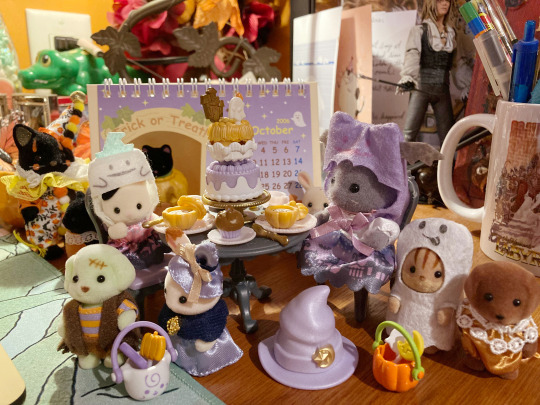
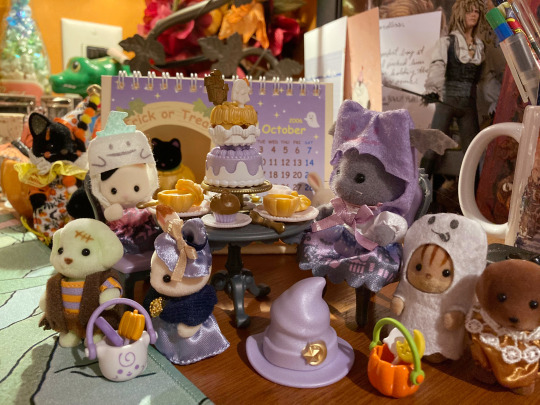

It's spooky critter season 🎃
#the calendar is actually from the london collector's store and just so happens to match up with the dates of 2023#pay no attention to the fact it says 2006 and everything is fine#i miss that store already#but I got so much cool vintage stuff in the closing sale#sylvanian families#calico critters#halloween#kidcore#toy collection#toy store#toy photography#collectable#fall#spooky#october#cute#my post
197 notes
·
View notes
Text
witch hat atelier is so beautiful and kind and lovely and i have so so much respect and admiration for shirahama kamome for a million reasons. which includes the fact that she basically said "fuck you" to figuring out a plumbing system and replaced it with a black hole to vacuum up shit and piss
#i had SO many questions when i read this#do nonmagical households have this???#do they pay witches to come and do the 'plumbing' for them????#or are they limited to like chamber pot style methods#witch hat atelier#tongari boushi no atelier#sou says stuff#anyways hi!! i am still here it's just been. you know.
53 notes
·
View notes
Text
PENIS PENIS PENIS PENIS PENIS
PUSSY.
BIG FLAPPY WET JESUS PUSSY.
JESUS' SOPPING WET PUSS-PUSS
[Edited months after posting to discourage catholics from replying to this post after finding that both the nice and much funnier not-nice responses to this were equally bad for my mental health. I didn't wanna delete it bc I was quite proud of some of my responses and it helps to have a visual reminder of why I left an abusive organization. Also, this means that any catholic who has reblogged this in an attempt to convert me, has now reblogged a post that, if clicked, links back to this. Use MY post for propaganda, will you!]
Thinking about how it was never made clear to me in Catholic school exactly WHY Jesus died for our sins. I just remembered that I was literally never clear on who the dying helped??
I've heard theories as an adult, but basically what I'm saying is pointless martyrdom seems a little pointless, and also with enough propaganda the big logical gaps in a belief system get really hard to see. Especially if questioning anything is blasphemy.
I would have gotten in so much trouble for insisting the teacher explain how Jesus helped us by being tortured to death by Romans even when God could have prevented it! God sent his only Son, they would have said! Be grateful, they'd say! Be guilty! Stop asking why he did that!!!
#original#religious trauma#<- what's up guys why did he do that??? for real i was raised catholic and it is FUCKING UNCLEAR but also the basis of a huge chunk of#my childhood?? like WHY though? my friend madeleine said it was related to animal sacrifices with the lamb of god stuff and all#this was NEVER mentioned in my school. i thought he was the lamb bc he followed god but maybe not#no wonder my impulse as a person is to constantly sacrifice myself unnecessarily#i think martyrdom is a bad gift. but i guess torture your son to death or whatever dude. but it's weird to do that and say it was for me#like...... thanks?? you're literally omnipotent but this is like the worst possible version of a cat leaving a dead mouse on my bed#Christianity#thank goodness i was too much of a fag to stay. i was so unhappy there.#the good place actually addresses a lot of my issues with Christianity as a whole while also not being all about Christianity#like what does it mean to condemn a person capable of change to eternal hell?M#*hell??#the good place#god pays the devil's rent y'all. like in that post that made my long beautiful essay about this irrelevant by#summing it up with 'girl they are in cahoots.' i think about that post all the fukn time nothing i can write longform is as punchy as that
409 notes
·
View notes
Note
To be honest, I ponder about Vanilla's prospects for redemption. Presently, the outlook appears bleak as Shadow Milk gradually recovers while mentally tormenting PV. It's a bit uncertain for me whether this coexistence can endure indefinitely. Now the situation to me looks like there is absolutely no hope that it will be possible to get rid of SM. Is Vanilla simply prolonging the inevitable or is there a glimmer of hope for eventual freedom?
Ooh I adore this question!!
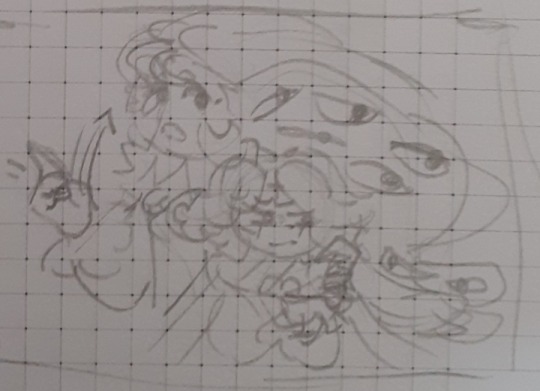
In terms of redemption, Pure Vanilla has gotten the chance to try and get to know more about his counterpart, but he doubts it would be possible as Shadow Milk's too far gone in terms of corruption. And certainly is not letting go of his ideals.
The situation is pretty bad but hope is there, the deal has some perks outside of the loss of freedom, mostly revolving on Shadow Milk and Pure Vanilla not being able to damage eachother.
The beast needed a disguise to keep up appearences, while the other wanted to have the possibility of going outside of the void he'd otherwise be confined to. Thus, Shadow Milk can't break or injure Pure Vanilla..at least not until his plan succeeds. This due to injuries reflecting on himself as well, and any unusual change in the ancient would signal that something is going on to anyone that knows him well.
What Vanilla had originally in mind was protecting others even if he was going to take a burden, so he's pretty much stalling while trying to contact the others without notice.
There is still hope, but finding a way to get Shadow Milk out that doesn't involve killing/sealing away the other too is going to be difficult.
#i'll just say bad endings are not my thing#all the hard work and pv's gamble will pay off in one way or another#askbox stuff#silly AU asks!!#intertwined opposites au#pure vanilla cookie#shadow milk cookie#crk au#tecnically the two being bound by a deal is almost like having the virtue of knowledge whole again#but with instability#both were separated as individual beings and reuniting two things this vastly different from eachother has concequences#tldr: the pain caused by shifting leads is mostly caused by this#just felt like adding that extra ramble/silly#apologies for any incorrect grammar sbfjshfb#beetle's ramblings
40 notes
·
View notes
Text

I will be closing my Redbubble store at the end of the year, these are the only 3 illustrations left if anyone still wants to get anything (prints and other goodies like notebooks, tote bags, shirts, etc).
From now on my Inprnt store will be the only place where my art prints will be available.
#redbubble#inprnt#PSA#eleonor says stuff#art prints#I'm very sorry to everyone from Europe because getting things from inprnt is a pain (customs)#but redbubble pays MISERABLY to the artists#like literal cents sometimes lol even when YOU are paying upwards of 20 dollars/euros#inprnt pays artists much better#support living artists! the human kind of artists ❤
75 notes
·
View notes
Text
i jeep making the mistake of opening twitter the people there are so STUPID
#they are talking abt the tommy arg thing like it was evidence of wilbur abusing him#when he left and came back covered in mud#oh my goddddd#that was FAKE it was FAKE#wilbur wasn’t even THERE#he was doing a BIT#someone is like omg he’s clearly dissociating#can you go outside? can you stop making stuff up so you can victimize your white boy? and pay attention to the confirmed ACTUAL victims???#vees train of thought#im not saying tommy can’t possibly be a victim but this is NOT the way to go abt speculating#when there are DEFINTIVE victims already speaking up#vent#abuse
48 notes
·
View notes
Photo
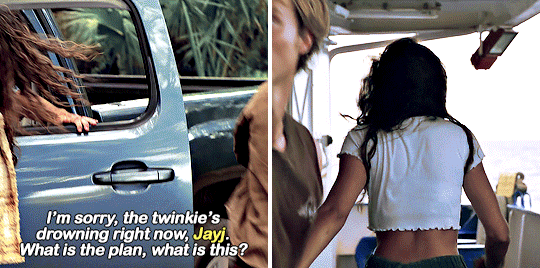


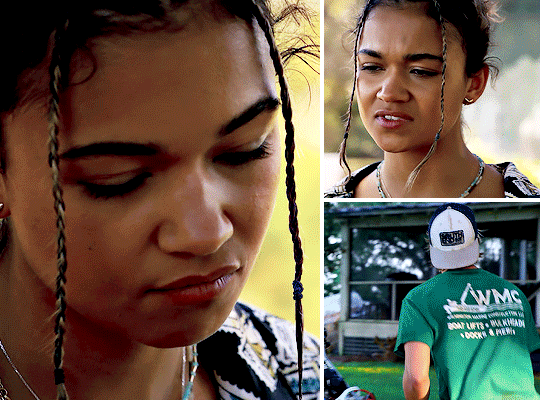



Kiara + “Jayj”
#obx#obxedit#outerbanksedit#obxhub#outer banks#jiara#jiaraedit#usermagda#userlinnea#jackpearcsn#tuserbea#userrobin#userbbelcher#dailynetflix#lydiaas#userserin#anyone saying jayj came out of nowhere wasn't paying attention in s2#bailey started her agenda early#obx*#reina makes stuff
366 notes
·
View notes